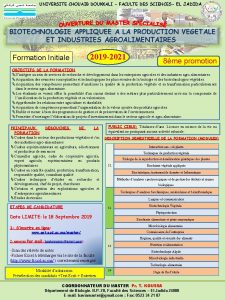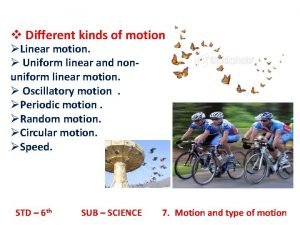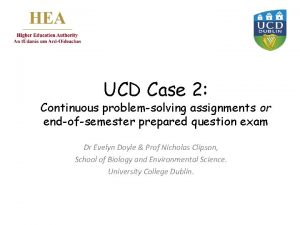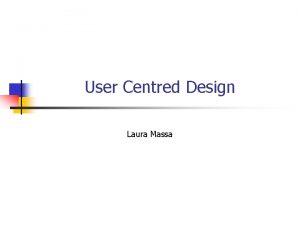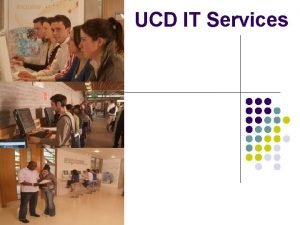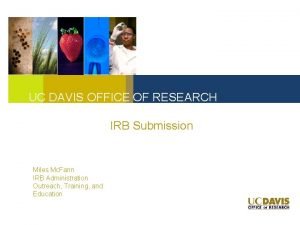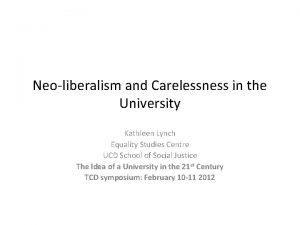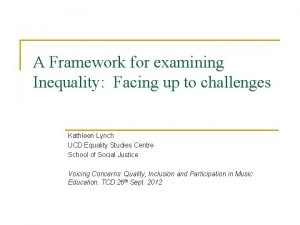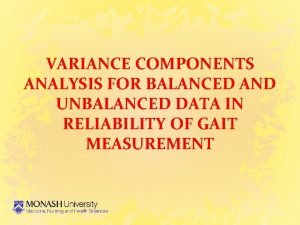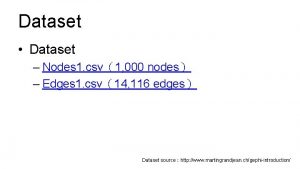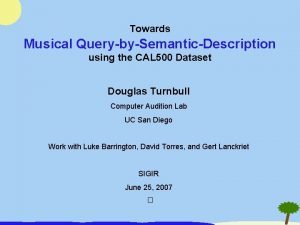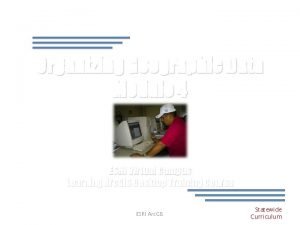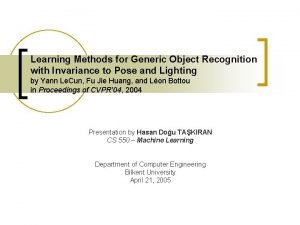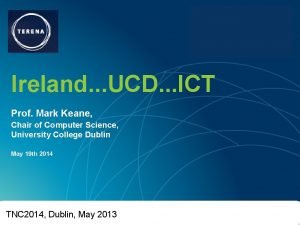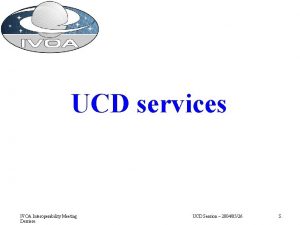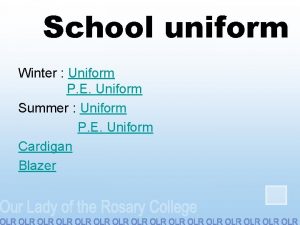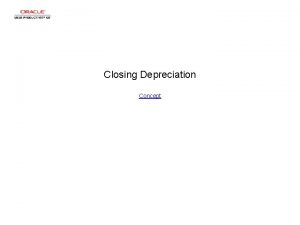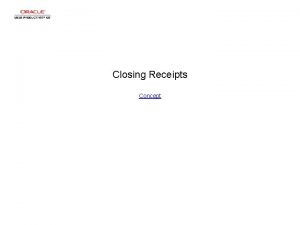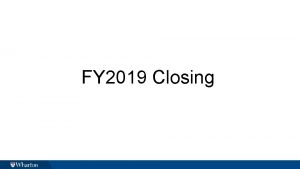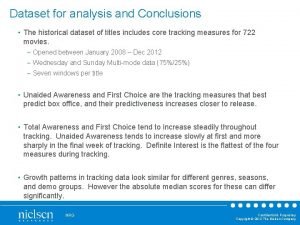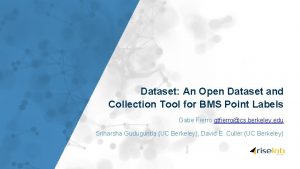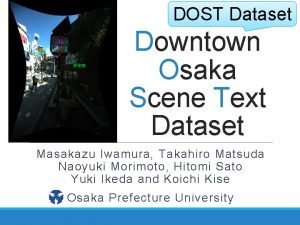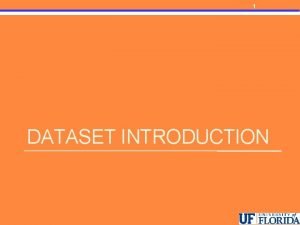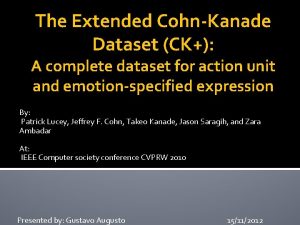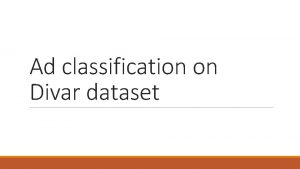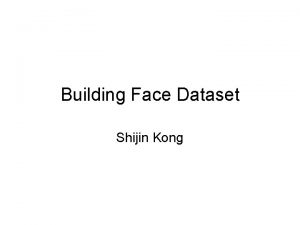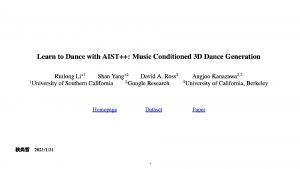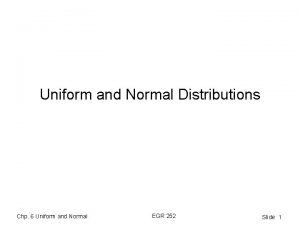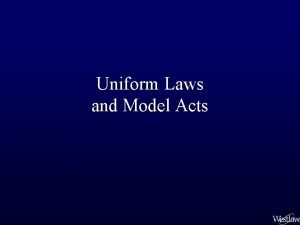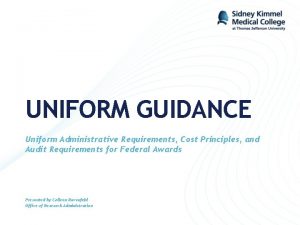July 31 2017 Uniform Closing Dataset UCD and


























- Slides: 26

July 31, 2017 Uniform Closing Dataset (UCD) and FAQ John Haring, Director Compliance Enablement

Forward Looking Statements and Confidentiality This presentation may contain forward-looking statements under the safe harbor provisions under The Private Securities Litigation Reform Act of 1995. These forward-looking statements may include the company’s ability and timing to enhance the features and functionality of Encompass software and services and of new product launches. Additional risks and uncertainties related to the company’s business are discussed in the company’s Securities and Exchange Commission filings, including but not limited to the company’s most recent Annual Report on Form 10 -K and Quarterly Report on Form 10 -Q. Unless otherwise required by applicable laws, the company undertakes no obligation to update or revise any forward-looking statements, whether as a result of new information, future events or otherwise. The presentation is current as of July 30, 2017. It does not contain legal interpretations, legal guidance, or legal advice. Its content is intended for general information purposes only. It should not be construed as legal advice or opinion on any specific facts or circumstances. You are advised to consult your own compliance staff or attorney regarding your specific residential mortgage lending questions or situation to ensure your compliance with applicable laws and regulations. The content is confidential to Ellie Mae and should not be discussed or shared with anyone outside of your organization. © 2017 Ellie Mae. All rights reserved. Confidential Material. 12/7/2020 2

Agenda • UCD Overview • Available Resources • Frequently Asked Questions • Additional Questions

UCD Overview © 2016 Ellie Mae. All rights reserved. 12/7/2020 4

UCD Background The UCD is a common industry dataset that allows information on the Consumer Financial Protection Bureau’s (CFPB’s) Closing Disclosure to be communicated electronically. The GSEs have developed the UCD at the direction of the Federal Housing Finance Agency (FHFA) as part of the Uniform Mortgage Data Program® (UMDP®), an ongoing initiative to enhance loan quality and consistency through uniform loan data standards for the single-family loans the GSEs purchase. © 2016 Ellie Mae. All rights reserved. 12/7/2020 5

UCD Requirements Updates GSE Mandate: • • • Note Dates delivered on or after September 25, 2017 (no change) Requirement to embed PDF optional 9/25/17, mandatory no earlier than April 2018 Inclusion Seller CD optional 9/25/17, mandatory Q 3 2018. Use of Alternative CD optional 9/25/17, mandatory on Refi’s Q 3 2018. Collection of expanded contact information (e. g. Identifier. Owner. URL attribute) expected by “Best Effort” Redelivery of CD and UCD not required in 2018. 2019 requirements differ by GSE • • Fannie Mae – must redeliver within 90 days after the loan is delivered and purchased by Fannie Mae if there are ANY changes to the UCD file Freddie Mac – must redeliver (timing TBA) in those instances where changes to the UCD file impact the purchase eligibility of the loan.

Preparing for the Delivering the UCD Things to Remember: § UCD is based on the MISMO v 3. 3. 0 § The UCD XML file is the same for both GSEs - there are no Fannie Mae- or Freddie Mac-specific UCD data requirements. § Delivery of UCD must occur prior to delivery. § UCD XML file must comply with the data requirements in Appendix H/I: UCD Delivery Specification. § The GSEs are NOT requiring signatures on the Closing Disclosure at this time. § A PDF copy of the most recent Closing Disclosure, including any associated addenda to the Closing Disclosure, must be embedded in the UCD XML file. The data provided in the UCD XML file must match the data on the PDF of the Closing Disclosure.

Collection of the UCD q Freddie Mac and Fannie Mae will have independent collection solutions but are aligned on the UCD format and when in the process it will be collected (at or before delivery). q Both GSEs will have a manual upload capability and direct integration § § § ALIGNMENT UCD file format Data conditionality and conditionality details Mandate for delivery Adequate time for testing and delivery Commitment to support vendors and lenders DIFFERENCES § Testing and collection mechanisms § Testing and system implementation timeline § Training and support materials for collection mechanism For more information on the GSE’s collection solution, refer each GSE’s UCD page Freddie Mac Uniform Closing Dataset: http: //www. freddiemac. com/singlefamily/sell/ucd. html Fannie Mae Uniform Closing Dataset: https: //www. fanniemae. com/singlefamily/uniform-closing-dataset

Available Resources © 2016 Ellie Mae. All rights reserved. 12/7/2020 9

GSE UCD Dedicated Websites Common Resources • Announcements • Dataset Specifications • Sample XML Files • Webinars, Fact Sheets and Tool Kits • Email List Registration https: //www. fanniemae. com/singlefamily/uniform-closing-dataset http: //www. freddiemac. com/singlefamily/sell/ucd. html © 2016 Ellie Mae. All rights reserved. 12/7/2020 10

Coming soon… New UCD Landing Page on Resource Center under development • Guides and Documents • Release Notes • Webinars • UCD User Forum • UCD FAQ’s • UCD Trending Issues © 2016 Ellie Mae. All rights reserved. 12/7/2020 11

Frequently Asked Questions 12

Frequently Asked Questions 1. How will systems produce the UCD export file? A. Many LOS’s leverage either current data in the loan file or historic disclosure data to populate the UCD export. Check with your vendor to determine the source of the data being reported and how the PDF being embedded within the export is being identified

Frequently Asked Questions 2. Can vendors convert a Closing Disclosure PDF into to UCD export file? A. Although a great amount of data in the UCD export file comes from information seen on the Closing Disclosure, not all of the information required to be provided is actually shown on the Closing Disclosure. As a result converting a PDF to UCD export file is not a viable option to be able to provide a comprehensive UCD export file.

Frequently Asked Questions 3. How are UCD files submitted to the GSE’s? A. There are generally two ways to submit a UCD file to the GSE’s. • Through Direct Integrations with both Fannie Mae and Freddie Mac. • By uploading a file directly to either Fannie Mae’s UCD Collection Solution or Freddie Mac’s Loan Closing Advisor websites.

Frequently Asked Questions 4. Are Lenders expected to submit the UCD to Aggregators? A. Loan Delivery requirements may vary by aggregator. Typically a lender must first upload a final CD submission to one or both of the GSE UCD Portals and obtain the successful submission certificate(s), and assign the UCD file to their aggregator through the GSE UCD portal(s). The lender would also deliver the certificate as part of the closed loan package. Some aggregators may also request a copy of the UCD Export File that was uploaded to the GSEs.

Frequently Asked Questions 5. What are UCD Fee Types? A. UCD Fee Types are MISMO based standardized fee descriptions used to promote a common understanding of what a fee is for regardless of what kind of description is shown on the Closing Disclosure.

Frequently Asked Questions 6. What is the difference between UCD Fee Types and MISMO Fee Types? A. Although UCD Fee Types are based on MISMO Fee Types, the GSE’s did not adopt all MISMO Fee Types so the UCD Fee Types are a subset of the total MISMO Fee Types. There is an option to use “Other” for any fee description that does not align with a UCD Fee Type.

Frequently Asked Questions 7. Where can someone find how a fee type is defined? A. Definitions for MISMO fee types can be found at www. mismo. org.

Frequently Asked Questions 8. Are fees the only Closing Disclosure data that have to be mapped to specific enumerations? A. In addition to fees, items that appear as any of Adjustments and Other Credits, Summaries of Transactions or Payoffs and Payments have expected enumerated values. Like fees, “Other” is an option for loan scenarios that don’t align with a specific enumeration provided.

Frequently Asked Questions 9. How do vendors support the ability to report a split CD scenario (e. g. borrower and seller receive separate disclosures)? A. Each vendor may approach this slightly differently but the common requirements are that in a split CD scenario the UCD XML format is modified to contain both a borrower and seller sections of data. Additionally, both the borrower’s and seller’s CD are expected to be embedded in the XML. Consult with your vendor on how they support the storage and reporting of seller side data particularly if the seller CD is being provided by a settlement agent.

Frequently Asked Questions 10. How are Case Numbers Assigned? A. In most cases the GSE’s will use the case number assigned by either DU or LPA as the UCD case number. In most cases, the GSE UCD collection solutions will assign a case number if a file is submitted without one. For example, In scenarios where a loan is submitted to Fannie Mae’s UCD Collection Solution that was not previously underwritten by DU, the UCD collection solution would issue a Case Number that would have to be referenced with any resubmission.

Frequently Asked Questions 11. Can the UCD export report both a DU Case File ID and a LPA Key simultaneously? A. Because some aggregators may require the UCD file to be submitted to both GSE’s, the UCD XML file will support both a DU Case File ID and LPA Key within the same XML file.

Frequently Asked Questions 12. Do the GSE’s support batch uploads? A. There is some limited support to receive more than one UCD submission at a time utilizing AS 2 technology. The number of files that can be submitted will depend on the total file size attempting to be delivered. Check with your vendor for more information.

Frequently Asked Questions 13. How do UCD files get assigned to an aggregator? A. Generally speaking, a lender uses the respective UCD collection portal to establish a relationship with an aggregator and then assigning that file to the aggregator after receiving a successful submission by going into the assignments area and selecting the aggregator from the list of established relationships. A lender may initiate or withdraw an assignment at any time. Likewise an aggregator can accept or reject an assignment at any time.

Questions?
 Uniform closing disclosure
Uniform closing disclosure Faculté des sciences el jadida
Faculté des sciences el jadida How do you classify uniform and non-uniform mixtures?
How do you classify uniform and non-uniform mixtures? Grade 7 science unit 3: mixtures and solutions answers
Grade 7 science unit 3: mixtures and solutions answers Uniform flow
Uniform flow Linear motion images
Linear motion images Ucd library database
Ucd library database Evelyn doyle ucd
Evelyn doyle ucd Massa ucd
Massa ucd Ucd it services
Ucd it services Ucd organisational chart
Ucd organisational chart Gerald mills ucd
Gerald mills ucd Ucd exchange
Ucd exchange Irb uc davis
Irb uc davis Slidetodoc.com
Slidetodoc.com Kathleen lynch ucd
Kathleen lynch ucd Kathleen lynch ucd
Kathleen lynch ucd Balanced and unbalanced dataset
Balanced and unbalanced dataset Nodes and edges dataset csv
Nodes and edges dataset csv European climate assessment and dataset
European climate assessment and dataset May june july
May june july Hansen dataset
Hansen dataset Adaboostclassifier
Adaboostclassifier Cal500 dataset
Cal500 dataset Feature dataset vs feature class
Feature dataset vs feature class Mse econometrics
Mse econometrics 432x18
432x18

